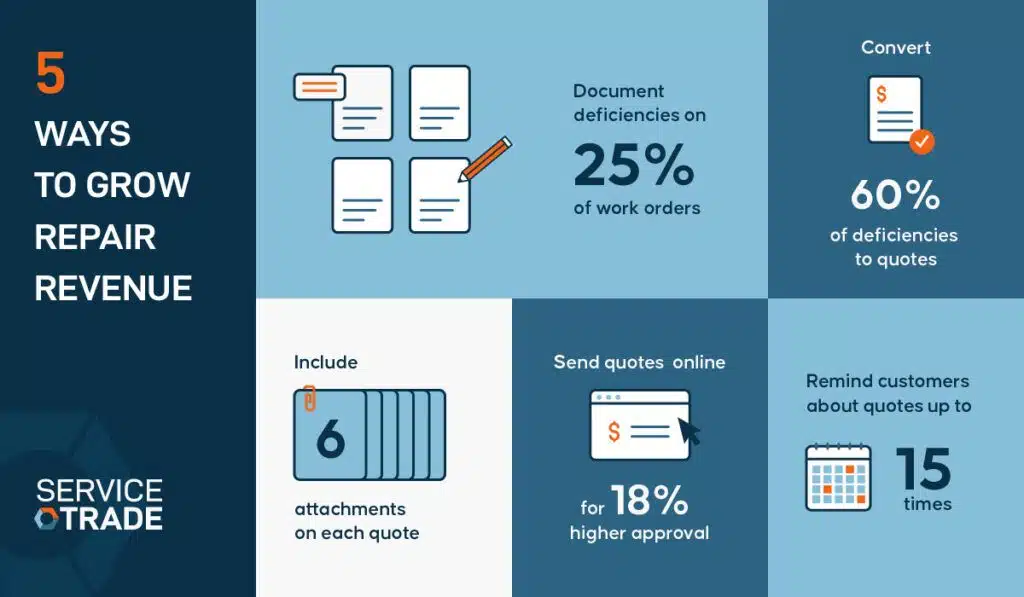The Key to Boosting Quote Approvals? Follow Up (A Lot).
Getting your customers to notice repair quotes amid their crowded inbox and busy schedules can be challenging. Persistent follow-up is essential to ensure that your quotes get the attention they deserve. This article explores the importance of follow-up and provides practical steps to enhance your follow-up process.

How Following Up (A Lot) Impacts Revenue
Successfully capturing your customers’ attention increases the likelihood of quote approvals, thereby boosting repair revenue. Data shows that sending multiple email reminders significantly increases the chances of quote approval. Contractors who send up to 15 reminders see a continuous rise in approval rates, highlighting the importance of persistence.
For instance, a contractor who implements an automated follow-up system can ensure that no quote is overlooked. By persistently reminding customers about open quotes, you increase the chances of approvals, leading to more completed repairs and higher revenue.
How Following Up Mitigates Risk
Persistent reminders increase the likelihood that clients will approve necessary repairs, ensuring compliance and safety for their facilities. This proactive approach reduces the risk of incidents and potential claims against your business. In the event of a liability claim, having a record of follow-up communications demonstrates due diligence and your commitment to addressing identified deficiencies.
Additionally, follow-up reminders help maintain open communication with your clients, reinforcing the importance of timely repairs. This can prevent small issues from escalating into major problems, protecting both your business and your customers.
What You’ll Need to Send More Reminders
To efficiently manage follow-up communications, you need a structured process and the right tools. Here’s what to consider:
Automated Reminder Systems: Utilize software that can automate email reminders, ensuring consistent follow-up without manual effort.
Established Follow-Up Cadence: Develop a schedule for sending reminders. Aim for a strategic number of reminders, such as up to 15, to maximize approval rates.
Clear Communication: Ensure that each reminder clearly states the importance of the pending quote and the urgency of the required repairs.
Steps to Improve Follow-Up
Personalize Messages: Personalize follow-up emails to address the specific concerns and needs of each customer. Tailored messages are more likely to capture attention and elicit a response.
Track and Adjust: Monitor the effectiveness of your follow-up reminders and adjust your strategy as needed. Track metrics such as open rates and approval rates to identify areas for improvement.
Use Multiple Channels: In addition to email reminders, consider using other communication channels, such as phone calls or text messages, to follow up on pending quotes. Diversifying your approach can increase the chances of getting a response from customers.
–
Persistent follow-up is crucial for increasing quote approvals and ensuring that identified deficiencies are addressed promptly. Find out what else you can do to optimize your deficiency management workflows: The Deficiency Efficiency Guide: 5 Steps to Higher Revenue and Safer Facilities


You’ve invested in software. You’ve digitized processes. You’ve built dashboards. Yet somehow, your team still asks, “Whose numbers are right?” You’re not alone. Many commercial service contractors invest heavily in data tools only to see minimal ROI. The problem usually isn’t the technology—it’s one of these five critical failures. Failure #1: Skipping Stages The mistake: […]
When Total Fire Protection integrated ServiceTrade with their Sage 300 CRE accounting system, something remarkable happened: invoicing time dropped from weeks to 1-2 days. But the real story isn’t about speed—it’s about what those weeks of delay were actually costing them. Every day an invoice sat waiting for manual data entry was a day of […]